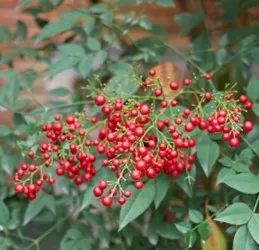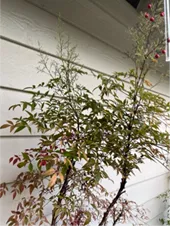I learned something today that both surprised and shocked me. Nandina domestica, more commonly known as Heavenly Bamboo or Chinese Sacred Bamboo is a member of the dirty dozen.[1] (No I'm not referencing the 1947 movie of that name starring Lee Marvin!) The “Dirty Dozen” that I'm referencing is a list of twelve of the most problematic plants from the Lewis Ginter Botanical Gardens located in Richmond, VA. I discovered the “Dirty Dozen” after reading an article in the Washington Post[2] where the author described his discoveries after joining the state-sponsored organization, the Virginia Master Naturalists. He learned that all his garden work had produced plants with no ecological value and some that did real harm. What piqued my interest was the authors following comment on Nandina, “it's cyanide-laced berries poison birds”![3] Another way that this plant is considered invasive is due to how easily the seeds are spread by wildlife. Once established, Nandina often crowds out natives especially plants that can feed wildlife and pollinators.[4]

I immediately began to research only to find the information I found verified with the exception that it is not considered invasive in CA! In fact this plant is not actually bamboo at all. Nandina domestica is an erect, evergreen, glaborous shrub that can grow up to 8' tall and 4' wide. It is part of the Berberidaceae (barberry) family of plants producing bright red berries amid green foliage. It grows in multi-stemmed clumps which are produced by the growth of rhizomatous underground stems and superficially resembles bamboo. Its leaves are alternate, shaped like pointed ovals, bi- or tri-pinnately compound, 1' to 2' long with leaflets that are 3/4”-3” long, leathery and have acuminate tips. The leaflets are wedge-shaped at the base, with entire margins. They are red in spring, blue green in summer, and purple-red in the fall. In winter the leaflets turn fiery red in a giant splash of color! It has pink flowers when it buds, which ultimately turn white with yellow anthers, each being .2”-.5” in length, on long panicles. Its berries are bright red, .32” in diameter, ripening in early fall and persisting through the winter.
Nandina domestica likes moist conditions but is afraid of standing water. During its growing period in spring and summer, water it every day and during a period of low humidity it loves to be misted! Slow down on water during the winter. This is a fertilizer-loving plant so if planting in a pot or the ground add a layer of soil then add an organic fertilizer (water-soluble preferred) higher in phosphorus and potassium and lower in nitrogen once or twice a month (optimally, we never fertilized ours which never stopped it from growing!) Nandina's growth slows in the fall so fertilization should slow as well. It helps to apply fertilizer once before the winter and stop until it enters its growing period once again.
Heavenly Bamboo loves light, and you'll find that without 7-9 hours of sunlight daily they will be spindly, but with enough light the stems will grow thick producing a hardier plant. It also prefers well-draining hummus soil[5] that is slightly acidic.[6]
N. domestica has been grown in both Chinese and Japanese gardens for centuries. It was brought to the West by the Scottish gardener and plant hunter William Kerr in 1804. It gets its name “Nandina” from the Japanese name “nanten” meaning ‘domesticated' or ‘of the household. In Japan Nandina is so popular that a national Nandina society exists.

Even though this plant is not considered invasive in California, ALL parts of the plant are poisonous because it contains compounds that decompose producing hydrogen cyanide and could be fatal if ingested. It is considered Toxicity Category Four, which is non-toxic to humans but is so to grazing animals and cats.[7] My cats have been around this plant their entire life and have simply ignored it so despite the warnings my grass eating critters have displayed no interest in Nandina whatsoever! After reading up, and loving the look of Nandina I have decided to remove the plant anyway and plant something that is in harmony with the birds and critters that I live with as well as being native to this area! I am once again reminded of the benefits of planting natives in my garden!
[1] Lewis Ginter Botanical Garden “Nandina: A “Dirty Dozen” Plant by Sarah Coffey
[2] Washington Post- Opinion piece by Dana Millbank- “I'm no genius with genuses, but your garden is killing the Earth”
[3] Image taken of Author's Nandina domestica
[4] Wikipedia- “Nandina”
[5] Missouri Botanical Gardens- Nandina domestica
[6] Gardenerswrld.com- by BBC Gardener's World Magazine- “How to grow Nandina”
[7] Wikipedia-Nandina

